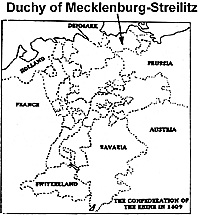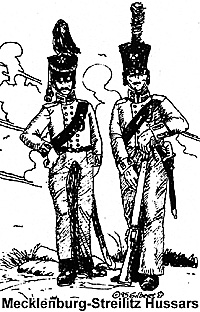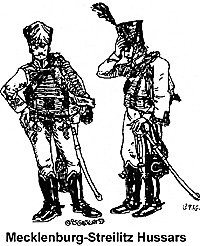 In response to queries from several readers about this unit, we would like to present the uniform of the Mecklenburg-Strelitz Hussar Regiment. The regiment served with the Prussian army during the Wars of Liberation 1813-15 and is often mistakenly identified as a Prussian army unit.
In response to queries from several readers about this unit, we would like to present the uniform of the Mecklenburg-Strelitz Hussar Regiment. The regiment served with the Prussian army during the Wars of Liberation 1813-15 and is often mistakenly identified as a Prussian army unit.
The duchy of Mecklenburg-Strelitz is the smaller of the two Mecklenburg duchies located in northeastern Germany (the other is Mecklenburg-Schwerin). In February of 1808, it became one of the last principalities to join the Confederation of the Rhine (Rheinbund) and agreed to provide a light infantry battalion for the 7th Rheinbund Regiment. In early 1813, Mecklenburg-Strelitz became one of the first German states to leave the Confederation of the Rhine. Because of family ties and sympathy with the rising tide of German nationalism, the duchy aligned itself with Prussia and its monarch, Prince Karl, became a Prussian general.
Regiment Called
In April, 1813 the prince called for the raising of a hussar regiment. It was to consist of 4 squadrons and was commanded by Lt. Colonel von Warburg. By July, the regiment had completed its formation and departed Mecklenburg for the Prussian army. It was attached to Yorck's Ist Prussian Army Corps as the cavalry regiment for the 2nd Brigade led by Prince Karl. At the outbreak of hostilities in August, the regiment's strength totaled 470 officers and men in 4 squadrons and a volunteer Jäger unit of 50 men.
 The regiment served with the brigade in the 1813 fall campaign participating in the battles on the Bober and the Katzbach with Blücher's Army of Silesia. Its place in the sun occurred during the Battle of Leipzig where, during the fighting on the north around Möckern, the regiment captured the eagle of the 1st French naval infantry regiment (1er Regiment d'artillerie de Marine). Subsequently, the hussars participated in the 1814 campaign with the 2nd Brigade and was demobilized in March, 1815. Upon Napoleon's return in June, the regiment was reformed and served with the German contingents. It was finally disbanded in March, 1816.
The regiment served with the brigade in the 1813 fall campaign participating in the battles on the Bober and the Katzbach with Blücher's Army of Silesia. Its place in the sun occurred during the Battle of Leipzig where, during the fighting on the north around Möckern, the regiment captured the eagle of the 1st French naval infantry regiment (1er Regiment d'artillerie de Marine). Subsequently, the hussars participated in the 1814 campaign with the 2nd Brigade and was demobilized in March, 1815. Upon Napoleon's return in June, the regiment was reformed and served with the German contingents. It was finally disbanded in March, 1816.
The hussars wore the traditional Hungarian hussar uniform of dolman and pelisse. Both dolman and pelisse were black with yellow braid and brass buttons. Cuffs on the dolman were black piped with yellow. Fur on the pelisse was white. A barrel sash of alternating black and yellow vertical bands was worn around the waist. Headgear consisted of a black belltop shako which was decorated with a brass "Wendish" cross on the front and the national cockade on the to front brim. A black plume was worn for parade purposes. Breeches were bright blue with yellow Hungarian knots on the thighs. Apparently, these breeches were also worn on campaign (in addition to Prussian cavalry overalls and French infantry breeches). Black leather Hungarian boots trimmed with yellow lace and tassels completed the picture.
 Belts were black leather. Sabers had brass hilts and their scabbards were black with brass fittings. Saber knots were black. The sabretache was also black decorated with a brass crowned C monogram. Carbines of a light cavalry pattern were carried. Horse furniture consisted of a black sheepskin with bright blue dogtooth edging and black leather harness.
Belts were black leather. Sabers had brass hilts and their scabbards were black with brass fittings. Saber knots were black. The sabretache was also black decorated with a brass crowned C monogram. Carbines of a light cavalry pattern were carried. Horse furniture consisted of a black sheepskin with bright blue dogtooth edging and black leather harness.
Officers' distinctions were limited to gold braid and lace replacing the yellow of the other ranks, a dark blue plume with the lower third scarlet and gold metalwork on sword and scabbard. In addition, the pouchbelt was decorated with a gold picker and chain. Musicians were distinguished by black plumes with scarlet tips.
The volunteer Jägers wore dark green dolmans with black collar and cuffs. The pelisse was also dark green with black fur trim. Braid remained yellow on both dolman and pelisse and the barrel sash was the same worn by the other hussars. The shako plume worn for dress was dark green as was the saber knot. Equipment was identical to the rest of the regiment. Horse furniture also followed the rest of the regiment except that dark green dogtooth edging replaced the bright blue.
Sources:
Friederich, Rudolf Geschichte des Herbstfeldzuges 1813, Mittler und Sohn, Berlin 1906 (Appendices only; my text copy is unfortunately missing)
Herrmann, Friedrich Mecklenburgische Uniformen 1813-1815, Zeitschrift für Heereskunde, Nr. 262, November/December, 1975
Nafziger, George Napoleon at Dresden, Emperor's Press, Chicago, IL, 1994
Rawkins, W. J. The Confederation of the Rhine, Rawkins Books, Norfolk, England, 1980.
Back to Empire, Eagles, & Lions Table of Contents Vol. 3 No. 2
Back to EEL List of Issues
Back to MagWeb Master Magazine List
© Copyright 1997 by Jean Lochet
This article appears in MagWeb (Magazine Web) on the Internet World Wide Web.
Other military history articles and gaming articles are available at http://www.magweb.com
